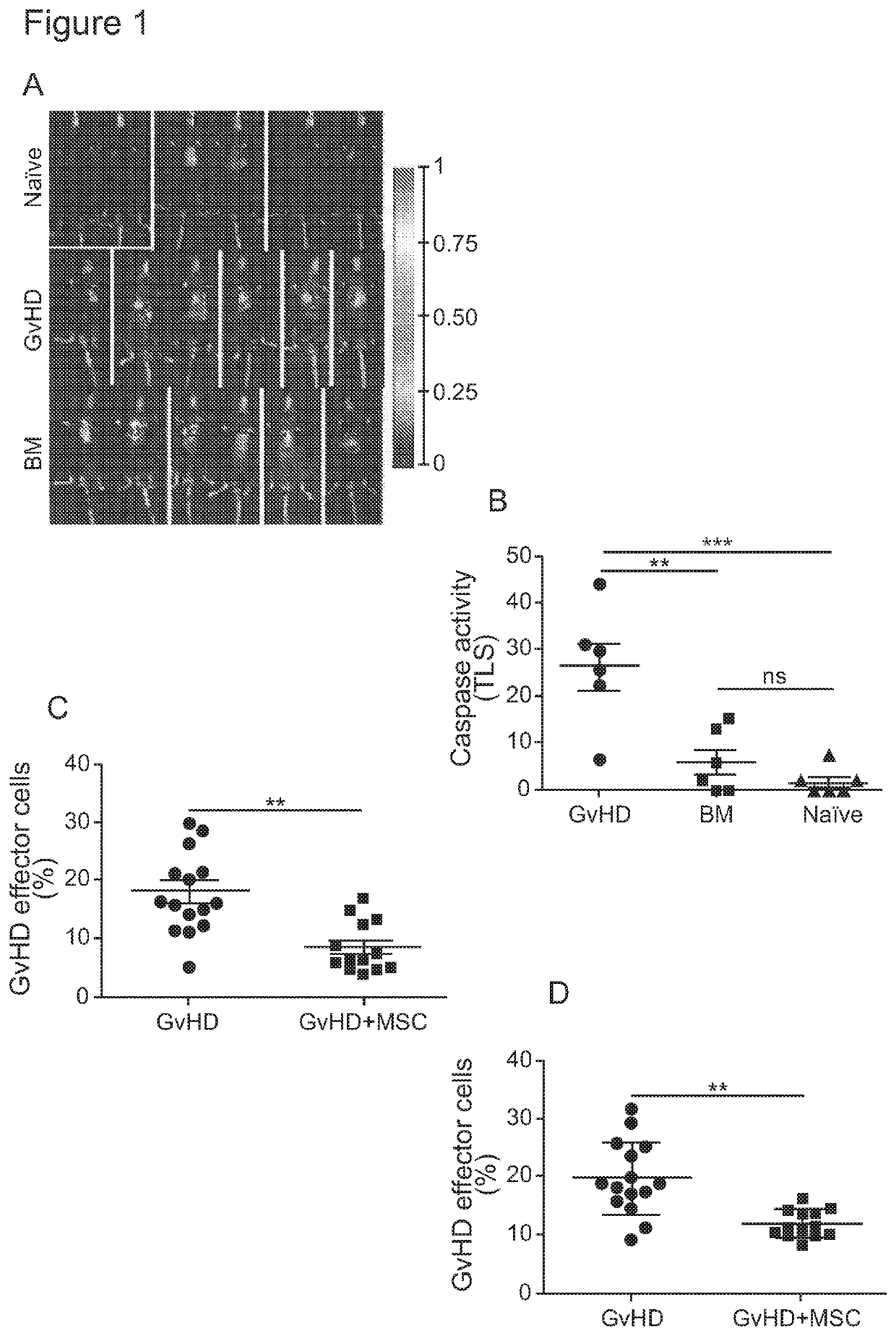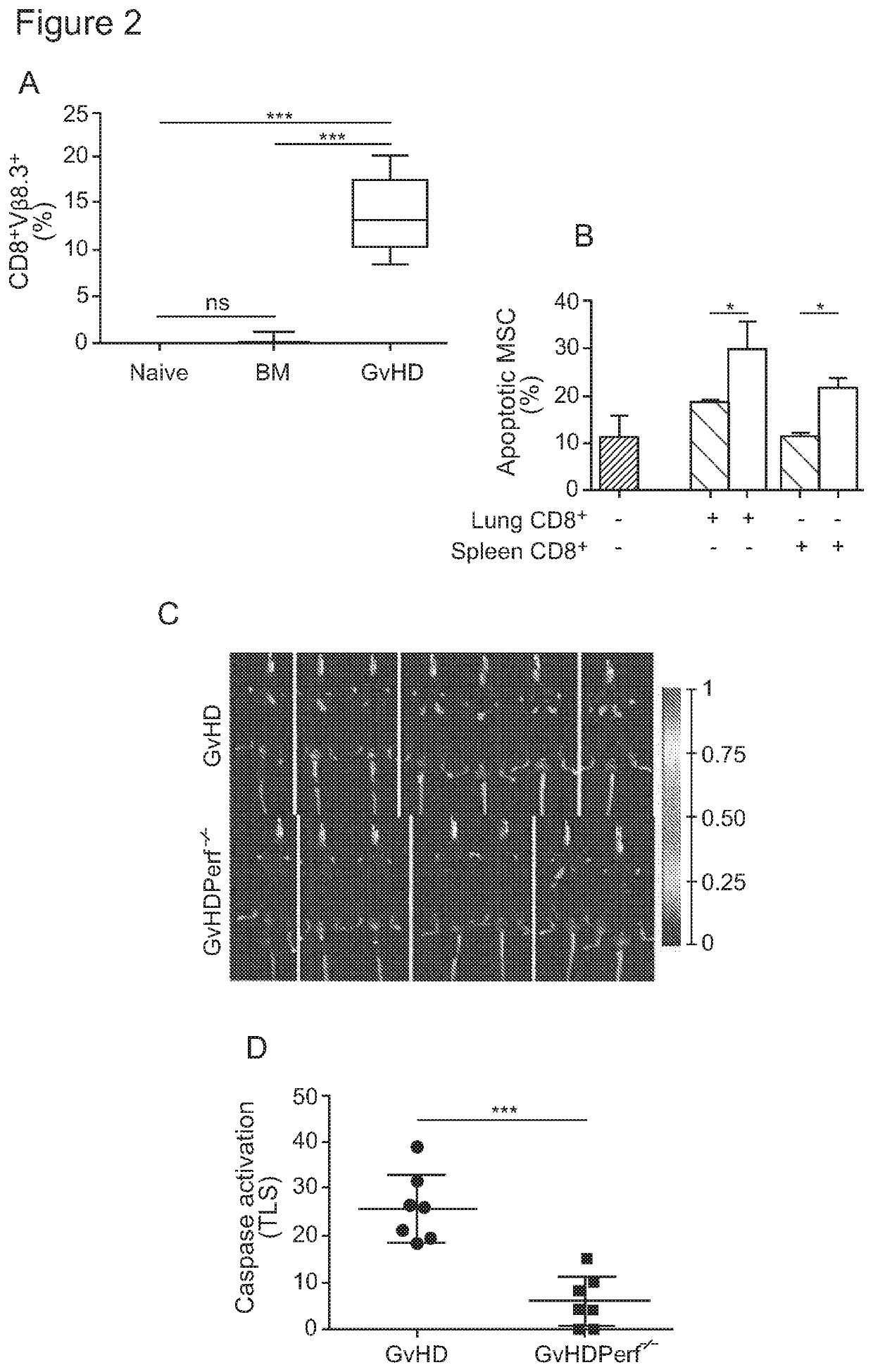Therapeutic substances, their preparation and diagnostic procedure
a technology of therapeutic substances and preparation, applied in the field of therapeutic substances, their preparation and diagnostic procedures, can solve the problem that the therapeutic effect cannot be delivered to recipients, and achieve the effect of suppressing the expansion/infiltration of the gvhd effector cells
- Summary
- Abstract
- Description
- Claims
- Application Information
AI Technical Summary
Benefits of technology
Problems solved by technology
Method used
Image
Examples
example 1
MSC Undergo Apoptosis in Recipient GvHD Animals.
[0134]In order to explain the mechanism by which MSC are rapidly cleared after injection, the applicants tested the hypothesis that MSC undergo apoptosis in a mice model of GvHD.
[0135]C57BL / 6 (H2b) mice were purchased from Harlan Laboratories (Bicester, UK). Mh (C5761 / 6 background, CD8+Tg, H-2b, CD45.2+, H-2Db-restricted) mice are transgenic for a T-cell receptor specific for the male antigen UTY presented in the context of H-Db, and were bred in-house. All mice were used between 6 and 12 weeks of age.
[0136]Acute GvHD was induced as previously described (T. Toubai et al. Blood, 119, 3844-3853 (2012)). Briefly, after lethal irradiation (11 Gy), recipient C57BL / 6 male mice were transplanted with 1×106 purified CD8+ cells transgenic for a T-cell receptor specific for the male HY-antigen Uty (Matahari, Mh) from female Mh mice as GvHD effectors (FIG. 9A), 5×106 unfractionated bone marrow (BM) and 2×106 purified polyclonal CD4+ cells from fe...
example 2
[0142]In vivo MSC apoptosis depends on activated recipient GvHD effector cells Our results show that MSC rapidly undergo apoptosis after infusion, providing the long-sought after explanation for the rapid clearance of transplanted MSC in the recipient. The absence of in vivo MSC apoptosis in naïve and BM mice clearly demonstrates that MSC apoptosis is not the result of xenogeneic recognition of human MSC, because it is detected only in GvHD mice. When we enumerated GvHD effector cell infiltrate (CD8+Vβ8.3+) in the lungs of mice, where MSC apoptosis occurs, we found that only the lungs of GvHD but not naïve and BM mice contained a large proportion of CD8+Vβ8.3+ cells (FIG. 2A), thus confirming the correlation between caspase activation in MSC and the presence of GvHD effector cells.
[0143]To test the hypothesis that GvHD effector cells were responsible for MSC apoptosis, MSC were cultivated with CD8+ T cells purified from the lungs or spleens of GvHD (in vivo activated) or naïve Mh (i...
example 3
Cytotoxic Activity Against MSC is a Biomarker Predictive of Clinical Response to MSC in GvHD Patients
[0146]Based on these findings, we inferred that the presence of cytotoxic cells in the recipient could be predictive of MSC therapeutic activity.
[0147]16 patients (mean age 40.5 years (range: 10-69), with severe steroid resistant grade 3-4 GvHD were treated with MSC in various hospitals over a period of years. MSC were administered for compassionate use (according to Regulation (EC) No 1394 / 2007). Patients had received a myeloablative or reduced-intensity conditioning prior to hematopoietic stem cell transplantation. All patients received GvHD prophylaxis with 3 or 4 doses of methotrexate combined with cyclosporine. T-cell depletion with alemtuzumab or ATG was performed in all adult patients transplanted in the UK centers. Of the 16 patients included in the study, 13 developed GVHD following hematopoietic stem cell transplantation, and the remaining 3 after DLI. 12 patients were affe...
PUM
| Property | Measurement | Unit |
|---|---|---|
| time | aaaaa | aaaaa |
| concentrations | aaaaa | aaaaa |
| concentrations | aaaaa | aaaaa |
Abstract
Description
Claims
Application Information
 Login to View More
Login to View More - R&D
- Intellectual Property
- Life Sciences
- Materials
- Tech Scout
- Unparalleled Data Quality
- Higher Quality Content
- 60% Fewer Hallucinations
Browse by: Latest US Patents, China's latest patents, Technical Efficacy Thesaurus, Application Domain, Technology Topic, Popular Technical Reports.
© 2025 PatSnap. All rights reserved.Legal|Privacy policy|Modern Slavery Act Transparency Statement|Sitemap|About US| Contact US: help@patsnap.com



